Hesperornis regalis Marsh, 1872

Phylum: Chordata Haeckel, 1874
Subphylum: Vertebrata Cuvier, 1812
Classe: Aves Linnaeus, 1758
Ordine: Hesperornithiformes Fürbringer, 1888
Famiglia: Hesperornithidae Marsh, 1880
Genere: Hesperornis Marsh, 1872
Descrizione
Di grandi dimensioni (superava un metro di lunghezza), questo uccello primitivo era adattato straordinariamente alla vita acquatica: il corpo era lungo e affusolato, dotato di due zampe posteriori poderose e probabilmente dotate di membrane interdigitali con le quali si spostava velocemente in acqua. Il collo allungato sosteneva un cranio munito di becco dentato, per mezzo del quale l'esperornite arpionava i pesci che gli capitavano a tiro. Le "ali" erano ridotte a semplici moncherini, ed erano virtualmente inutilizzabili. Molti fossili di questo uccello sono stati rinvenuti nel Kansas, nei terreni cretacei di Niobrara. A quel tempo, circa 85 milioni di anni fa, l'interno del Nordamerica era costituito da un vero e proprio oceano, che separava le due estremità del continente. Questo oceano era abitato da rettili marini di dimensioni gigantesche, come Elasmosaurus, Brachauchenius e i mosasauri, per i quali l'esperornite era una potenziale preda. La specie di gran lunga più conosciuta di esperornite è Hesperornis regalis, tipica del Kansas, ma altre specie sono state rinvenute in tutto il Nordamerica e in Asia. Altre forme simili, riunite nell'ordine degli esperornitiformi, sono conosciute fino alla fine del Cretaceo: da citare Asiahesperornis, Baptornis e Parahesperornis.
Diffusione
Uccello estinto, fossile del tardo Cretaceo, i cui resti sono stati rinvenuti in Nordamerica e in Asia.
Bibliografia
–Keiichi Aotsuka; Tamaki Sato (2016). "Hesperornithiformes (Aves: Ornithurae) from the Upper Cretaceous Pierre Shale, Southern Manitoba, Canada". Cretaceous Research. in press: 154-169.
–Perrins, Christopher (1987) [1979]. Harrison, C.J.O. (ed.). Birds: Their Lifes, Their Ways, Their World. Pleasantville, NY, US: Reader's Digest Association, Inc. pp. 165-166. ISBN 0895770652.
–Marsh, Othniel Charles (1880): Odontornithes, a Monograph on the Extinct Toothed Birds of North America. Government Printing Office, Washington DC.
–Gregory, Joseph T. (1952). "The Jaws of the Cretaceous Toothed Birds, Ichthyornis and Hesperornis" (PDF). Condor. 54 (2): 73-88.
–Heironymus, T.L.; Witmer, L.M. (2010). "Homology and evolution of avian compound rhamphothecae" (PDF). The Auk. 127 (3): 590-604.
–Elzanowski, A. (1991). "New observations on the skull of Hesperornis with reconstructions of the bony palate and otic region". Postilla. 207: 1-20.
–Holtz, Thomas R. Jr. (2011) Dinosaurs: The Most Complete, Up-to-Date Encyclopedia for Dinosaur Lovers of All Ages, Winter 2010 Appendix.
–Charles Schuchert and Clara Mae LeVene, O.C. Marsh: Pioneer in Paleontology, p. 427. New York: Arno Press, 1978. Later, Russell assisted Marsh while attending medical school; he became a surgeon, professor of Clinical Surgery in the Yale School of Medicine, and Marsh's personal physician until Marsh's death in 1899. See Proceedings of the Connecticut State Medical Society (Google eBook) and Genealogical and Family History of the State of Connecticut: A Record of the Achievements of Her People in the Making of a Commonwealth and the Founding of a Nation. Editorial staff: William Richard Cutter, Edward Henry Clement, Samuel Hart, Mary Kingsbury Talcott, Frederick Bostwick, Ezra Scollay Stearns. Volume I (of 4). New York: Lewis Historical Publishing Company, 1911.
–Carpenter, K. (2003). Harries, P. J (ed.). "Vertebrate Biostratigraphy of the Smoky Hill Chalk (Niobrara Formation) and the Sharon Springs Member (Pierre Shale)". High-Resolution Approaches in Stratigraphic Paleontology. Topics in Geobiology. 21: 421-437.
–Marsh, O.C. (1876). "Notice of new Odontornithes". The American Journal of Science and Arts. 11 (66): 509-511.
–Bell, A.; Everhart, M.J. (2009). "A new specimen of Parahesperornis (Aves: Hesperornithiformes) from the Smoky Hill Chalk (Early Campanian) of Western Kansas". Transactions of the Kansas Academy of Science. 112 (1/2): 7-14.
–Mortimer, Michael (2004): The Theropod Database: Phylogeny of taxa Archived 2013-05-16 at the Wayback Machine.
–Shufeldt, R.W. (1915). "Fossil birds in the Marsh Collection of Yale University". Transactions of the Connecticut Academy of Arts and Sciences. 19: 1-110.
–Martin, L.D. (1984). "A new hesperornithid and the relationships of the Mesozoic birds". Transactions of the Kansas Academy of Science. 87 (3/4): 141-150.
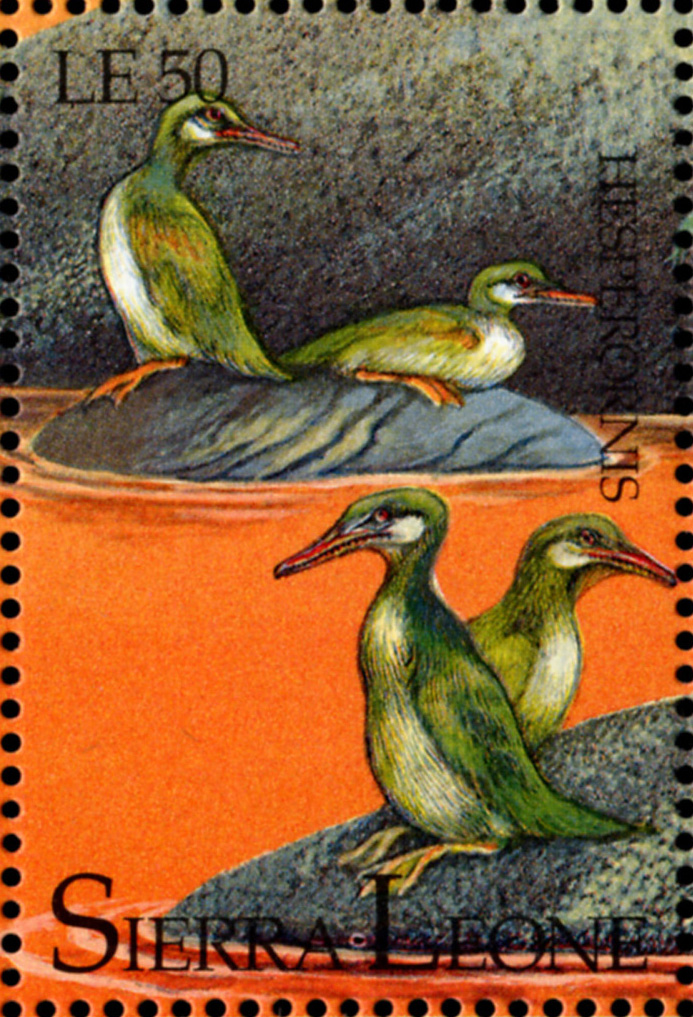
|
Data: 08/06/1992
Emissione: Animali preistorici Stato: Sierra Leone |
|---|
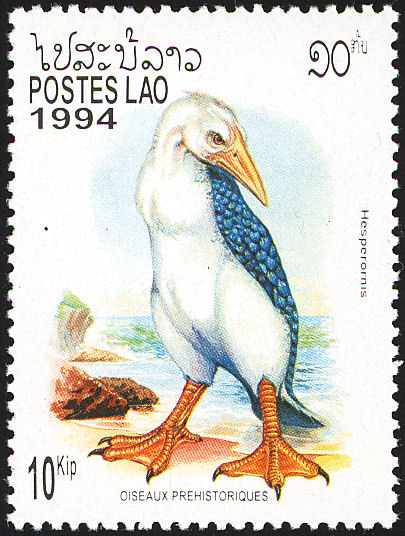
|
Data: 20/01/1994
Emissione: Animali estinti e preistorici Stato: Laos |
|---|
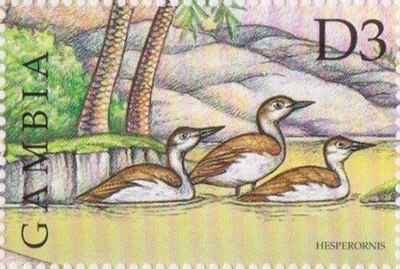
|
Data: 01/08/1999
Emissione: Animali preistorici Stato: Gambia |
|---|
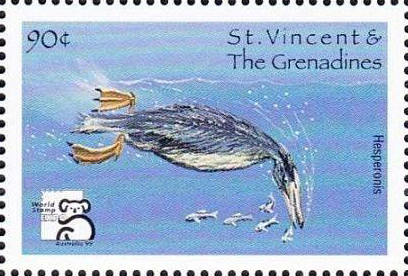
|
Data: 01/03/1999
Emissione: Mostra Filatelica Internazionale Australia 99 - Animali preistorici Stato: St. Vincent and the Grenadines Nota: Emesso in un foglietto di 12 v. diversi |
|---|
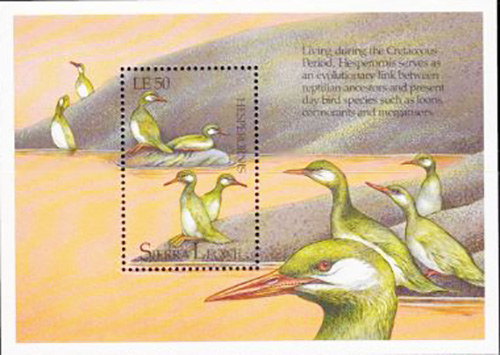
|
Data: 08/06/1992
Emissione: Animali preistorici Stato: Sierra Leone |
|---|